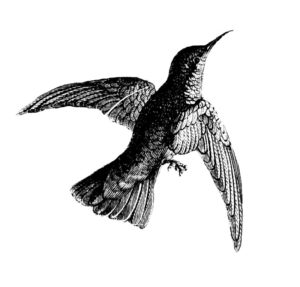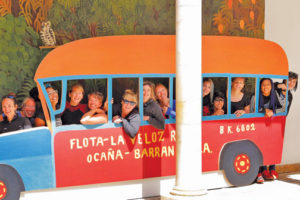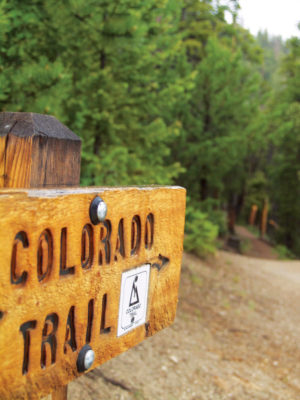By George Sibley
May and June are dominated here by the garden. Gardens, I should say; when we moved into our Gunnison home 20-some years ago, we were unimpressed with the expanse of bad lawn that came with it, and we resolved to annually convert 50 square feet of bad lawn to garden space. I lack my partner Maryo’s experience with plants, and undoubtedly some of her dedication – I mean, she grew tomatoes in a community garden in Chicago right by a bus stop, which involved defensive measures like painting the tomatoes with a flour mixture to make them look diseased to random hunter-gatherers. But I signed on as the project heavy-lifter, being no lover of monocultures, and now we have little gardens – some kind of growing together – all over the yard.
We have mostly made our average of 50 square feet a year, up until the past year. This has only reduced the original lawn by maybe a third, but after a big surge two years ago when we converted about 250 square feet of impossible grass out front to a graveled xeriscape garden, we realized that the growth of garden space was in growing tension with our aging backs and knees. We actually removed one small garden space this year that had been kind of in the way, filling it in with gravel for a drainage project (no net increase in lawn).
[InContentAdTwo]
Anyway, you get the picture. We began to see that one viable argument for lawns is relative ease of management. But the garden(s) – whew. They ask – no, demand, a lot – almost as much as they give. From mid-May to mid-June, one sees whole days disappear in getting the host of little starts waiting on the windowsill inside and the soils amended and ready for seeds. And from then on there’s never a time when there’s not something you could be doing for the plants, even if only checking their water (always needing something somewhere). Looking at these little plots, and their small yields, we have a more reality-based appreciation for the farmers who produce the incredible abundance on our supermarket shelves. Fresh produce year-round and multiple brands of everything including everything we don’t really need is a mundane, taken-for-granted miracle.
But now, at the end of June, with everything finally in the ground and all the perennials replaced that hadn’t come back, we’re able to stand back a little (hose in hand) and … wonder why the rutabagas and kale haven’t come up yet.
But it’s also time to sit on the back deck at the end of the day with a beer or two and begin to harvest the miracle – just a visual harvest for the next month or so – of what is being wrought by those little “programs” we call seeds, orchestrating the assembly from bits of dirt, dollops of water and breaths of air into this incredible array of flowers, leaves and limbs, this massing of greenness bejeweled with the full-color spectrum of life.
In that back-deck mode, I often find myself thinking about what we call “nature.” Actually, I find myself thinking about “nature” a lot lately, whether I’m sitting on the back deck, or out hiking in the mountains, or getting lost in Denver. So doing, I find myself wondering about the nature of nature.
We humans have tended to remove ourselves from nature. Emerson tried to articulate the dichotomy a couple centuries ago in his essay into “Nature,” in which he essentially divided the planet into “Nature” and “Art”: “Nature, in the common sense,” he said (always with a capital “N”), “refers to essences unchanged by man; space, air, the river, the leaf. Art is applied to the mixture of his will with the same things, as in a house, a canal, a statue, a picture.” We tend to maintain that kind of a distinction between “the natural world” and anything done by or for humans. When biologists or ecologists speak of “ecosystems,” they are usually talking about the communities of “natural” plants and animals that were in a place before humans arrived on the scene. The best argument for the weird theory that we humans were imported to the planet by aliens is the degree to which we seem to be alienated from any sense of our own naturalness ….
O
ne of our contemporary Emersons, Bill McKibben, carried Ralph Waldo’s dichotomy to its end point in his book The End of Nature. Using climate change due to human-caused carbon loading in the atmosphere as the final straw, McKibben essentially says there are no more “essences unchanged by man” left; we have mixed our will with just about everything on the planet. It is all art now, and some of it is undeniably bad art, as art goes, nothing anyone wants hanging in our living space anyway. That is probably “the nature of art”: art is always a venture into the unknown, and seldom does the artifact exactly reflect the purity of the initial vision. Sometimes our art improves on nature; sometimes it doesn’t; but it always changes the nature of something in some respect that addresses some perceived deficiency.
But with that noted, with a minimum of surliness (what! Nature’s not already perfect?!) – where do we get the idea that it is any different with “the natural world”? With capital-N “Nature,” as Emerson, McKibben and the other romantics tend to see it?
If we are able to free ourselves from the Eden Complex – the misbegotten belief that God or Nature gave us a perfect garden which we have ruined through unoriginal sins – if we can shake off that destructive myth, and truly look realistically at the natural world, the nature of nature gets complex pretty quickly.
One thing you might notice right off is that below and above the thin skin of the biosphere, there is an eternal elemental war going on that is magnificent to observe but even more mindless than most of the wars we mortals perpetrate on each other. The lithosphere – a collection of stone plates floating on the planet’s melted core – perpetually throws up volcanoes and mountain chains and other tectonic land masses from its internal fire, which the atmosphere perpetually works to erode, sandblast and otherwise destroy with moving air and water moved by its external solar fire. This massive, inexhaustible state of contention is spectacular in its frequent excesses, and often wildly beautiful. But it is certainly hard to interpret those particular aspects of nature’s nature as the working of a benevolent clockmaker.
That elemental contention is what we should maybe think of as the basic nature of the planet. But somehow, and we still don’t know exactly how, another very different nature emerged out of that basic nature – you could call it “the nature of life,” but I’m inclined to narrow it down to “the nature of plants” because plants are the only life forms that literally assemble themselves out of odd bits from the contentious elements in nature’s basic nature – mixing a little dirt, water and air – and eventually became the living things that do what can be done at the interface of atmosphere and lithosphere to gentle and tame that mindless elemental chaos of eruption and erosion: the grasses and trees that slow and contain the erosive flows of water, comb some of the violence out of the wind, give shade from the violence of the sun, make soils from roots breaking rock and hold soils together against the wind to nurture more life, including all us animals who live off of those plants.
Plants are the only things that shake my otherwise solid faith in the random nature of Darwinian evolution; they seem to be such avatars of a peaceable and coherent revolution against the violent and chaotic basic nature of the planet that one is tempted to imagine “intelligent design” operating, which of course implies an “intelligent designer.”
But if such an unimaginable intelligent force exists (remember Dylan Thomas’s great line: “the force that through the green fuse drives the flower”) – if such a force exists, I think it is only a “god of plants” that does not extend to animals (including us). We might best see ourselves as a “third nature” on earth – one that is still trying to figure out what we are going to evolve or revolve into when we grow up, since we obviously carry within ourselves elements of both of those other natures, our chaotic Trumpish ids with a struggling neocortical overlay of slowly compounding altruistic and plantlike better sense – still as thin as the skin of life on earth.
At the end of a day on the back deck, my personal back feeling the day’s labors in the dirt, I know what to do, if I can continue to muster the energy: work with the plants. Not out of some illusory memory of an Edenic garden that has never existed on our wild planet, but out of a vision for the garden planet it could be if we can survive and correct our bad art and capitalize on the art that works. Listen to the plants, look to the flowers (and eat the vegetables that are only good for you).
George Sibley is an aging beginner gardener in Gunnison.



